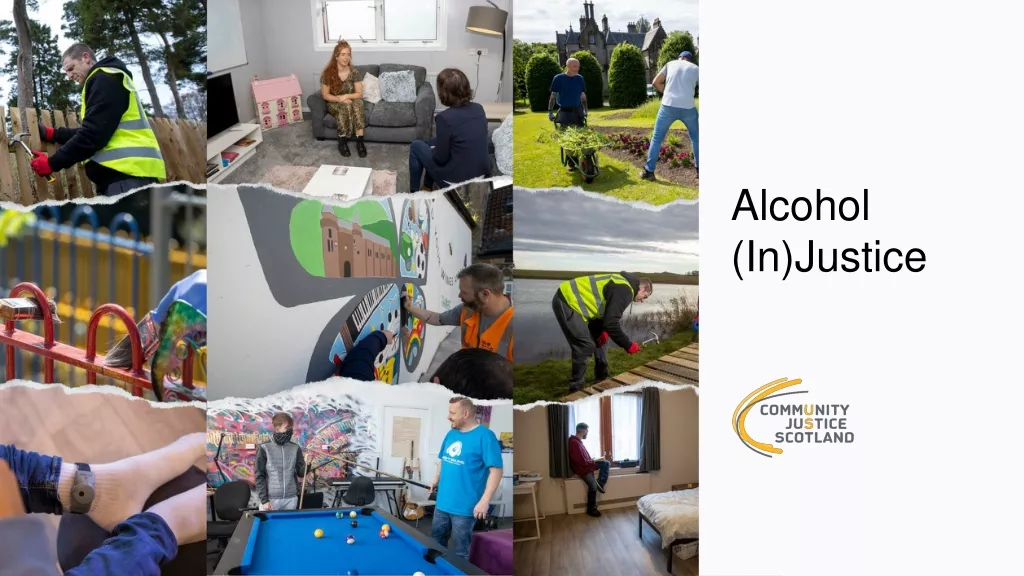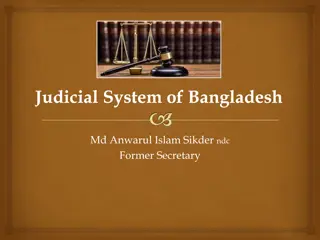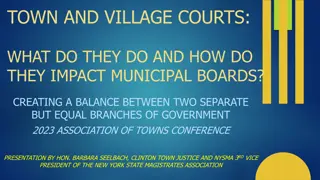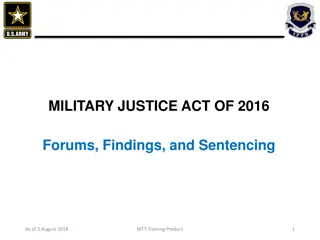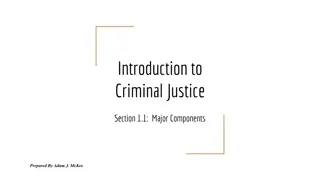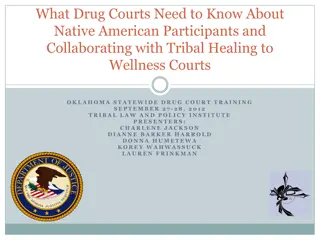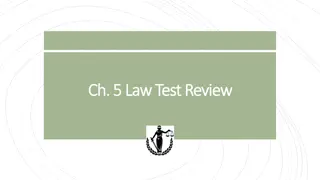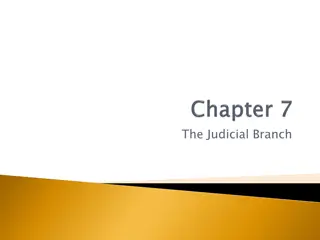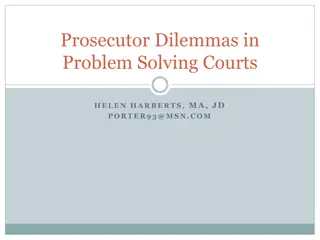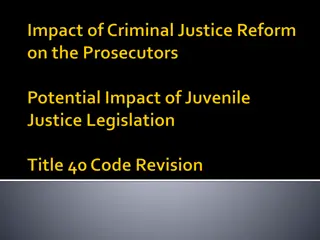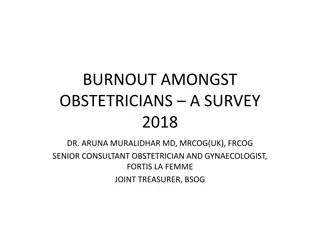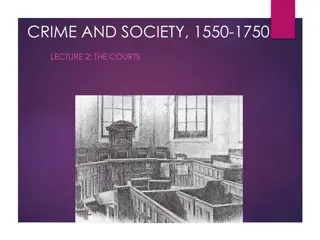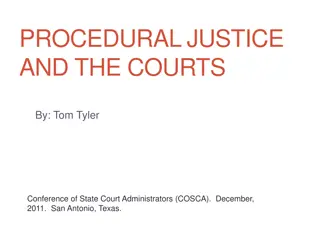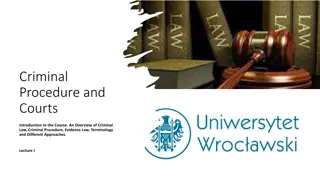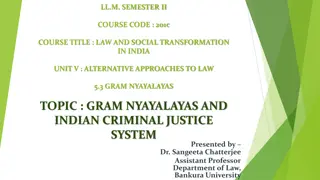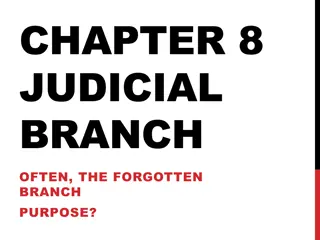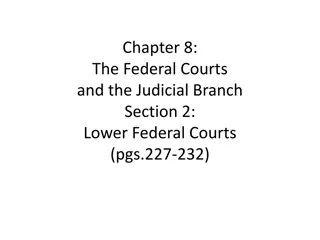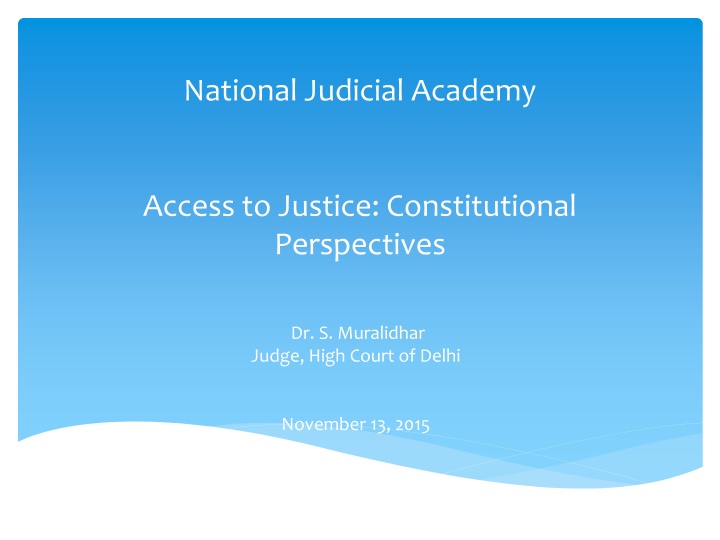
Understanding Access to Justice: Constitutional Perspectives
Explore the concept of justice, barriers to access to justice, state responses, and legal frameworks in the context of ensuring fair and equal treatment within the legal system. Discover the role of formal and informal legal systems, legal aid provisions, and institutions supporting access to justice.
Download Presentation

Please find below an Image/Link to download the presentation.
The content on the website is provided AS IS for your information and personal use only. It may not be sold, licensed, or shared on other websites without obtaining consent from the author. If you encounter any issues during the download, it is possible that the publisher has removed the file from their server.
You are allowed to download the files provided on this website for personal or commercial use, subject to the condition that they are used lawfully. All files are the property of their respective owners.
The content on the website is provided AS IS for your information and personal use only. It may not be sold, licensed, or shared on other websites without obtaining consent from the author.
E N D
Presentation Transcript
National Judicial Academy Access to Justice: Constitutional Perspectives Dr. S. Muralidhar Judge, High Court of Delhi November 13, 2015
Outline of the presentation Concept of Justice and Access to Justice Barriers to Access to Justice State s Response to Access to Justice Three waves of Access to justice Informal Legal Systems Challenges ahead An ideal legal service delivery model Agenda for change
Concepts: Justice and Access to Justice Justice implies fairness and the implicit recognition of the principle of equality Access to justice serves two purposes -ensures that every person is able to invoke the legal processes for redress irrespective of social or economic status or other incapacity, and -ensures that every person should receive a just and fair treatment within the legal system.
Barriers to Access to Justice Mystification of law and legal processes Privileging of sections of society and criminalizing poverty Dependence on lawyers Costs, delays and uncertainties Institutional model of state-sponsored legal aid Special disadvantages not limited to poverty, social status, economic status, gender, age, sexual orientation Failure to integrate the non-formal legal systems with the formal legal system
State Response to Access to Justice Constitution of India: Articles, 14,19,21,22,39-A Section 304 of the Code of Criminal Procedure, 1973: Legal aid to accused at State expense in certain cases Order 33 Code of Civil Procedure, 1908: Suits by Indigent Persons Legal Services Authorities Act, 1987 (Section 12: Criteria for giving Legal Services)+ Lok Adalats Arbitration and Conciliation Act, 1996 Gram Nyayalayas Act, 2008
State Response to Access to Justice National and State Human Rights Commission Commissions for Women Commissions for Protection of Child Rights Commission for Minorities Other Tribunals including those for accident claims, consumer disputes, debt recovery, issues related to employment under the State and the Armed Forces, telecom disputes etc. Delhi Government s mediation centres Public Grievances Commissions/Cells Permanent Lok Adalats of public utilities Other dispute resolution mechanisms including Crimes Against Women cells and committees for complaints of sexual harassment
Three waves of Access to Justice First Legal representation: the traditional model of legal aid which is based on providing representation to poor litigants in courts Second the expanded notion of locus standi class action and public interest litigation Third ADR: Mediation, Arbitration, Conciliation and Lok Adalats
Evolution of legal aid First Phase Pre-independence era: Introduction in the 17th century of the Anglo Saxon adversarial model of litigation Early recognition of the right under the 1898 CrPC Courts alive to the need to provide legal aid in criminal cases: Re: Llewelyn Evans AIR 1926 Bom 551 and P.K.Tare v. Emperor AIR 1943 Nag 26
The Second Phase Constitution: Articles 21, 22 and 39-A Expert Committees on Legal Aid Expert Committee on Legal Aid (Central Govt) (1973) Juridicare Committee (Central Govt) (1977) Committee on Implementation of Legal Aid Schemes (CILAS)
The Third Phase Enactment of the Legal Services Authorities Act 1987 Formalising the hiearchical and institutional model of legal services delivery Focus on Lok adalats and other pragmatic means of ensuring speedy justice A model of legal services delivery conceptualised and controlled by the judiciary Gram Nyayalayas Act 2008
Lawyers and Representation Issues concerning lawyers Availability of experienced and competent lawyers at all levels: Quality of legal services delivery Payment of commensurate fees Perception of the role of a lawyer as a legal service provider: State driven and not Bar driven Different models of use of lawyers for legal services: Amicus curiae, Pro-bono lawyers, duty solicitors
Response to the Problem Judicially evolved PIL Expanded notion of standing Informality of procedure Appointment of Commissioners Court reaching the problem, and treating it as a non-adversarial litigation. Monitoring of implementation Development of law in specific areas (human rights, environment, judicial accountability)
Response to the Problem PIL as a strategic arm of the legal aid movement. Issues addressed in initial years of PIL Conditions in custodial institutions Bonded agricultural labour and child labour under trials in jails Issues addressed in later years - Environment - Right to Food - Urban Life
Alternative Dispute Resolution Section 89 of the Code of Civil Procedure, 1908 Arbitration (Arbitration & Conciliation Act, 1996) Conciliation (Arbitration & Conciliation Act, 1996) Judicial settlement including settlement through Lok Adalats Mediation (Afcons Infrastructure Ltd. v. Cherian Varkey Construction Co. (P) Ltd. (2010) 8 SCC 24; Salem Advocate Bar Association v. Union of India (2003) 1 SCC 49)
The Legal Services Authorities Act, 1987 (LSAA) LSAA inspired by the draft legislation appended to the 1977 Report of the Juridicare Committee in two important features: Definition of `Legal services includes the giving of advice on any legal matter Special categories who are entitled to legal aid irrespective of their qualifying the means test
LSAA: The Institutional Structure Hierarchical pyramidical structure National Legal Services Authority State Legal Services Authorities Authorities at the High Courts District and Taluk levels.
LSAA: The Institutional Structure Composition: dominated by executive and judiciary Shift away from the beneficiary of legal services to the institution dispensing legal services. Sizable portion of the budget for salaries and maintenance of the establishment Co-option of the judiciary by the executive Multi-tasking by judges at district and taluk levels
Informal Legal Systems Paani Panchayats Khap Panchayats Katta Panchayats Shalishi Courts Naari Adalats Muslim Women s Jamaat Other caste, community dispute resolution mechanisms Parallel systems
Challenges Reluctance of people to engage with the Formal Legal System (FLS) A robust Non-formal Legal System (NFLS) Need to reorient the FLS as a people-centric system relevant to their problems Effectiveness of Lok Adalats : Bread for the Poor Identifying legal services needs and catering to them at the earliest point in time Integrated approach to law and legal services reform Critiquing the institutional model of legal services delivery Inter-disciplinary approach : Involve a wider cross-section of the society
Legal aid needs of the rural population Problems of security of land tenure; Availability of access to resources like clean drinking water, water transportation, and pricing and marketing of commodities; Availability of finances and repayment of loans taken for agricultural operations; Issues concerning agricultural labour; Displacement on account of manmade calamities (incl. Caste conflicts) and natural calamities; for irrigation,
Legal aid needs of the rural population Access healthcare and education; Loss of shelter and livelihood on account of forced displacement development projects Growing unemployment and lack of avenues on account of failure to develop alternative skills; Forced migration to cities seeking employment to basic facilities including primary to make way for
Agenda of the Legal Services Committees What the activities ought to include: - preventive legal aid elements like advice, counselling and mediation - Making it available at the point of entry into the system within closed penal institutions - social justice litigation on matters of special concern to the weaker sections of the society and for this purpose, give training to social workers in legal skills. (S. 4 (d) LSAA)
Programmatic Content and Implementation Visibility and Accessibility: Organise periodic visits to closed institutions (prisons, juvenile homes, police lock ups, women s shelters, beggars homes) by team of lawyers, doctors and social workers and follow up with remedial steps Awareness: Prepare brochures, pamphlets in the local language explaining laws, remedies: Tie up with local educational institutions to outsource such activity Outreach: Travel to urban slum clusters and remote corners of districts to increase visibility and enthuse participation by the disadvantaged sections in the legal services programmes constitutional rights and
An ideal legal services delivery model Preventive advice, pre-litigative resolution mechanisms at the nearest point in time and within easy reach This includes providing counselling, Remedial This envisages strengthening the existing models of providing legal assistance from the point of entry into the legal system till the point of exit Rehabilitative This envisages an expanded notion of providing legal services even beyond the litigative phase: Relevant for issues like bonded labour, child labour, persons who have been under involuntary incarceration in penal custodial institutions
Agenda for change Challenging the constitutionality of laws that criminalize poverty The use of law and institutional reform litigation as a strategic arm of the legal aid programme Legal aid as part of the overall package of welfare measures intended to support the economically and socially disadvantaged Sensitization of the judiciary Incentivizing lawyers participation Interdisciplinary approach Clinical legal aid Widening the range of legal service providers: para legals, civil society

